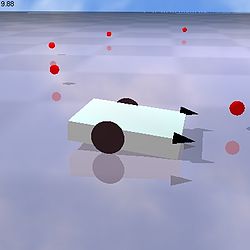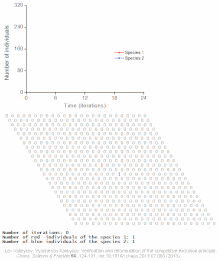“人工生命”的版本间的差异
(→复杂系统建模) |
(→复杂系统建模) |
||
| 第258行: | 第258行: | ||
===复杂系统建模=== | ===复杂系统建模=== | ||
| − | |||
| − | |||
| − | |||
| − | |||
| − | |||
| − | |||
[[复杂系统]]的数学模型分为三种:'''黑箱 black-box'''(现象学),'''白箱 White box'''(力学,基于第一原理)和灰箱 grey-box(现象学和力学模型的混合)。在黑箱模型中,基于个体的复杂动态系统机制仍然是个谜。<ref name="Kalmykov Lev V., Kalmykov Vyacheslav L. Solution">Kalmykov, Lev V.; Kalmykov, Vyacheslav L. (2015), "A Solution to the Biodiversity Paradox by Logical Deterministic Cellular Automata", Acta Biotheoretica, 63 (2): 1–19, doi:10.1007/s10441-015-9257-9, PMID 25980478, S2CID 2941481</ref> | [[复杂系统]]的数学模型分为三种:'''黑箱 black-box'''(现象学),'''白箱 White box'''(力学,基于第一原理)和灰箱 grey-box(现象学和力学模型的混合)。在黑箱模型中,基于个体的复杂动态系统机制仍然是个谜。<ref name="Kalmykov Lev V., Kalmykov Vyacheslav L. Solution">Kalmykov, Lev V.; Kalmykov, Vyacheslav L. (2015), "A Solution to the Biodiversity Paradox by Logical Deterministic Cellular Automata", Acta Biotheoretica, 63 (2): 1–19, doi:10.1007/s10441-015-9257-9, PMID 25980478, S2CID 2941481</ref> | ||
2020年10月21日 (三) 11:45的版本
人工生命 Artificial life(经常被缩写为ALife或者A-Life)是在电脑系统中,通过仿真模型、机器技术和生物化学方式,模拟自然生命系统来研究生命的过程及其演变的领域[1]。这个概念由美国理论生物学家克里斯托弗·朗顿 Christopher Langton于1986年提出。[2] 1987年,兰顿第一次在新墨西哥州的洛斯阿拉莫斯 Los Alamos, New Mexico举行了该领域的第一次会议。[3]
以研究方法命名,可将人工生命研究分为三类:[4]
1、软,通过软件模拟[5] 2、硬,通过硬件模拟[6] from hardware 3、湿,基于生物化学研究[7][8]
人工生命研究者尝试通过复现生命现象的各个方面来研究传统的生物学。

A Braitenberg vehicle simulation, programmed in breve, an artificial life simulator
用breve来编程的人工生命模拟 Braitenberg仿真小车
概述
人工生命研究人工环境中生命系统的基本过程,借此对定义此类系统的复杂信息进行更深入的理解。该研究角度涵盖深广,但通常会包括进化动力学 Evolutionary algorithm、集体系统的涌现特性、仿生学、对生命本质哲学研究的相关内容,以及艺术作品中逼真的生物描绘。
哲学讨论
人工生命的建模哲学,与传统的建模相比有显著差异,它不仅是研究“我们所知的生命 life-as-we-know-it”,而且去研究“生命可能的形式 life-as-it-might-be”。[9]
传统生物学模型会侧重于捕捉生命最重要的决定因素,与之相比,人工生命建模则想要破译隐藏在生命体中最简单、最通用的规则和原理,并在模拟中实现它们。模拟仿真方法为分析各种新出现的拟生系统提供了可能性。
Vladimir Georgievich Red'ko 建议将这一本质区别推广至任意过程的建模中,从而概括出“我们所知的过程 processes-as-we-know-them”与“他们可能是的过程 processes-as-they-could-be”作为更加广义的区分。[10]
目前,学界普遍不接受任何人工生命模拟符合生命定义的、或认为软件系统是活的。认为它们并不构成任何生态系统进化过程的一部分。然而对于人工生命的潜力,依然有很多不同观点:
- 强人工生命模拟立场认为(参见强AI),“生命是可以从任何特定的介质抽离的过程”(约翰·冯·诺依曼 John von Neumann)。值得注意的是,汤姆·雷 Tom Ray宣布,他的程序Tierra不是在计算机中模拟的生命,而是在其中成合成生命。[11]
- 弱人工生命模拟立场否认在化学溶液之外产生 ”生命过程“的可能性,期研究者转而尝试模拟生命过程,以理解生命现象的基本机理。
基于软件模拟人工生命 (软人工生命)
技术
- 元胞自动机 Cellular Automata在人工生命的早期就被使用了,因其简化可扩展性 scalability和并行化 parallelization 现在仍然经常被使用研究。人工生命与元胞自动机在历史上有着相当紧密的联系。
- 人工神经网络 Artificial neural network常常被用来对智能体大脑进行建模。虽然传统上它更多的是一种人工智能技术,但是神经网络对于模拟可以学习的生物种群动态非常重要。学习和进化之间的共生关系是关于具有较高神经复杂性的生物体中本能发展的理论的核心,例如,鲍德温效应 Baldwin effect。
著名的模拟器
下表列出了按照生物定义方法整理的人工生命/ 数字生物模拟器 。
| 姓名 | 驱动源 | 开始年份 | 结束年份 |
|---|---|---|---|
| ApeSDK(以前为Noble Ape)ApeSDK (formerly Noble Ape) | 语言/社会模拟language/social simulation | 1996 | 进行中 ongoing
|
| Avida阿维达 | executable DNA | 1993 | ongoing进行中
|
| Biogenesis生物起源 | executable DNA可执行 DNA | 2006 | ongoing进行中
|
| Neurokernel神经核 | Geppetto盖佩托(http://www.geppetto.org/)模拟平台 | 2014 | 进行中
|
| Creatures 生物 | neural net/simulated biochemistry神经网络 / 模拟生物化学 | 1996-2001 | Fandom still active to this day, some abortive attempts at new products狂热者一直活跃到今天,对新产品进行了一些失败的尝试
|
| Critterding | neural net神经网络 | 2005 | ongoing 进行中
|
| Darwinbots达尔文机器人 | 可执行的 DNAexecutable DNA | 2003 | ongoing进行中
|
| DigiHive | executable DNA可执行 DNA | 2006 | ongoing 进行中
|
| DOSE | executable DNA可执行 DNA | 2012 | ongoing正在进行
|
| EcoSim | Fuzzy Cognitive Map模糊认知地图 | 2009 | ongoing 进行中
|
| Framsticks 荧光棒 | executable DNA可执行 DNA | 1996 | ongoing进行中
|
| Geb盖布 | neural net神经网络 | 1997 | ongoing进行中
|
| OpenWorm | Geppetto盖佩托(http://www.geppetto.org/)模拟平台 | 2011 | ongoing进行中
|
| Polyworld多元世界 | neural net神经网络 | 1990 | ongoing
|
| Primordial Life原始生命 | executable DNA可执行 DNA | 1994 | 2003
|
| ScriptBots脚本机器人 | executable DNA可执行 DNA | 2010 | ongoing 进行中
|
| TechnoSphere技术圈 | modules模组 | 1995 |
|
| Tierra 铁拉 | executable DNA可执行 DNA | 1991 | 2004
|
| 3D Virtual Creature Evolution3D虚拟生物进化 | neural net神经网络 | 2008 | NA
|
基于程序模拟
基于程序的模拟包含具有复杂DNA语言(通常为图灵完备 Turing complete)的生物。这种语言通常是计算机程序的形式,而不是实际的生物DNA。汇编派生词是最常用的语言。生物体在执行其代码时会“存活”,通常有多种方法可以进行自我复制。变异通常是通过随机更改代码来实现的。元胞自动机是常见工具,但不是唯一的。也有人用人工智能和多主体系统来进行研究。
基于模块的模拟
基于模块的模拟是将单个模块添加到一个生物中。这些模块或者通过硬编码模拟(例如A型腿加快速度和新陈代谢)直接修改生物的行为和特征,或者通过生物模块之间的紧急交互作用间接地修改动物的行为和特征(例如A型腿以频率X上下移动,与其他腿部互动以产生运动)。一般来说,这些模拟器强调的是用户创造和可访问性,而不是突变和进化。
基于参数的模拟
生物体通常是由一系列预先定义的固定行为来构建的,这些行为受各种变异参数控制。也就是说,每个生物体都是一个包含数字或其他有限参数的集合。每个参数都明确地控制生物体的一个或多个方面。
基于神经网络的模拟
这些模拟让生物通过神经网络或近似衍生物进行学习和成长。通常强调的是学习,而不是自然选择,尽管并不总是如此。
复杂系统建模
复杂系统的数学模型分为三种:黑箱 black-box(现象学),白箱 White box(力学,基于第一原理)和灰箱 grey-box(现象学和力学模型的混合)。在黑箱模型中,基于个体的复杂动态系统机制仍然是个谜。[12] [13]
黑箱模型完全是非机械的。它们是现象学的,忽略了复杂系统的组成和内部结构。我们无法研究这种非透明模型的子系统之间的相互作用。复杂动态系统的白箱模型是透明的,直接显示了潜在的机制。在动态系统白箱模型演化的所有阶段,都可以直接看到微观、中观和宏观级别的所有事件。在大多数情况下,数学建模者使用纯数学的黑箱方法,这些方法无法生成复杂动态系统的机械模型。灰箱模型是中间模型,结合了黑箱方法和白箱方法。
复杂系统白箱模型的创建和先验的建模主体基础知识的必要性有关。确定性逻辑元胞自动机是白箱模型的必要条件,但不是充分条件。白箱模型的第二个必要先决条件是所研究对象的物理本体的存在。因为白箱建模完全基于主题的确定性逻辑和公理,因此,它代表了基于第一定律的自动超逻辑推断。白箱建模的目的是从基本公理中获得有关所研究对象动力学的更详细、更具体的机械知识。在创建对象的白箱模型之前必须制定对象的内在公理体系的必要性,可以根据任意逻辑规则将白箱类型的细胞自动机模型与细胞自动机模型区分开。如果尚未根据受试者的首要原理制定细胞自动机规则,则此类模型与实际问题的相关性可能较弱。[12]
对于单个有限资源,基于逻辑确定性个体的种间竞争元胞自动机模型。
Hardware-based ("hard")硬件模拟(”硬“)
Hardware-based artificial life mainly consist of robots, that is, automatically guided machines able to do tasks on their own.
Hardware-based artificial life mainly consist of robots, that is, automatically guided machines able to do tasks on their own.
硬件模拟人工生命主要由机器人组成,即能够独立完成任务的自动引导机器。
Biochemical-based ("wet")基于生物化学的研究(“湿的”)
生物化学基础(“湿”)
Biochemical-based life is studied in the field of synthetic biology. It involves e.g. the creation of synthetic DNA. The term "wet" is an extension of the term "wetware".
Biochemical-based life is studied in the field of synthetic biology. It involves e.g. the creation of synthetic DNA. The term "wet" is an extension of the term "wetware".
基于生化的人工生命研究,属于合成生物学领域研究。它涉及合成DNA的创建等,术语“湿”即拓展自“湿件 ”一词。
In May 2019, researchers, in a milestone effort, reported the creation of a new synthetic (possibly artificial) form of viable life, a variant of the bacteria Escherichia coli, by reducing the natural number of 64 codons in the bacterial genome to 59 codons instead, in order to encode 20 amino acids.[14][15]
In May 2019, researchers, in a milestone effort, reported the creation of a new synthetic (possibly artificial) form of viable life, a variant of the bacteria Escherichia coli, by reducing the natural number of 64 codons in the bacterial genome to 59 codons instead, in order to encode 20 amino acids.
2019年5月,研究人员在一项具有里程碑意义的工作中,报告通过将细菌基因组中自然数量的64个密码子减少到59个密码子,并编入20个氨基酸,创造了一种新的合成(可能是人工)形式的可行生命,一种大肠杆菌的变种。
Open problems 开放性问题
- How does life arise from the nonliving?
- Generate a molecular proto-organism in vitro.
- Achieve the transition to life in an artificial chemistry in silico.
- Determine whether fundamentally novel living organizations can exist.
- Simulate a unicellular organism over its entire life cycle.
- Explain how rules and symbols are generated from physical dynamics in living systems.
- 生命是如何从非生命中产生的?
- 在体外产生一种分子原生物。
- 从人工化学中的硅中实现向生命的过渡。
- 确定是否存在根本上独特的活组织。
- 模拟一个单细胞生物体的整个生命周期。
- 解释规则和符号是如何通过生命系统中的物理动力学生成的。
- What are the potentials and limits of living systems?
- Determine what is inevitable in the open-ended evolution of life.
- Determine minimal conditions for evolutionary transitions from specific to generic response systems.
- Create a formal framework for synthesizing dynamical hierarchies at all scales.
- Determine the predictability of evolutionary consequences of manipulating organisms and ecosystems.
- Develop a theory of information processing, information flow, and information generation for evolving systems.
- 生命系统的潜能和限制都是什么?
- 确定开放式生命进化中不可避免的是什么。
- 确定从特定反应系统到通用反应系统演化过渡的最低条件。
- 建立一个在所有尺度上综合动态层次结构的正式框架。
- 确定生物体和生态系统进化后果的可预测性。
- 发展一种信息处理、信息流和进化系统的信息生成理论。
- How is life related to mind, machines, and culture?
- Demonstrate the emergence of intelligence and mind in an artificial living system.
- Evaluate the influence of machines on the next major evolutionary transition of life.
- Provide a quantitative model of the interplay between cultural and biological evolution.
- Establish ethical principles for artificial life.
- 生命是如何与思想、机器和文化联系起来的?
- 演示人工生命系统中智能和思维的出现。
- 评估机器对生命下一次重大进化的影响。
- 提供文化和生物进化之间相互作用的定量模型。
- 建立人工生命伦理。
Related subjects 相关主题
1. Artificial intelligence has traditionally used a top down approach, while alife generally works from the bottom up.[18]
2. Artificial chemistry started as a method within the alife community to abstract the processes of chemical reactions.
3. Evolutionary algorithms are a practical application of the weak alife principle applied to optimization problems. Many optimization algorithms have been crafted which borrow from or closely mirror alife techniques. The primary difference lies in explicitly defining the fitness of an agent by its ability to solve a problem, instead of its ability to find food, reproduce, or avoid death.[citation needed] The following is a list of evolutionary algorithms closely related to and used in alife:
*Ant colony optimization
*Bacterial colony optimization
*Genetic algorithm
*Genetic programming
*Swarm intelligence
4. Multi-agent system – A multi-agent system is a computerized system composed of multiple interacting intelligent agents within an environment.
5. Evolutionary art uses techniques and methods from artificial life to create new forms of art.
6. Evolutionary music uses similar techniques, but applied to music instead of visual art.
7. Abiogenesis and the origin of life sometimes employ alife methodologies as well.
1. 传统人工智能使用自上而下的方法,而人工生命通常是自下而上的。
2. 人工化学最初是作为人工生命界中抽象化学反应过程的一种方法。
3. 进化算法是弱人工生命原理在优化问题的实际应用。许多优化算法都借鉴或密切反映了人工生命的技术。主要区别在于通过解决问题的能力而不是寻找食物、繁殖或避免死亡的能力来明确定义agent的适用性。主要区别在于前者明确地通过解决问题的能力来定义代理的适应性,而非单纯寻找食物、繁殖或避免死亡的能力。以下是与人工生命密切相关并经常使用的进化算法列表:
*蚁群优化(Ant colony optimization)
*细菌菌落优化(Bacterial colony optimization)
*遗传算法(Genetic algorithm)
*基因编程(Genetic programming)
*群体智能(Swarm intelligence)
4. 多代理系统是指在一个环境中由多个交互的智能代理组成的计算机系统
5. 进化艺术使用人工生命中的技术和方法来创造新的艺术形式。
6. 进化音乐也使用类似的技术,但其领域主要应用于音乐而非视觉艺术。
7. 生物创生和生命起源有时也会采用人工生命的方法。
History 历史
主要文章:人工生命历史
Criticism 批评
Alife has had a controversial history. John Maynard Smith criticized certain artificial life work in 1994 as "fact-free science".[19]
人工生命有一段颇受争议的历史。1994年,约翰·梅纳德·史密斯John Maynard Smith曾批评某些人工生命研究,称他们为“无事实的科学”。[20]
See also 另请参阅
人工意识 –认知科学领域
- 人工智能的应用
- 自主机器人
- 生物伦理学
- 杂的自适应系统
- 达尔文机
- 数字形态
- 出现 -复杂系统中的现象,其中相互作用产生的效果无法从子系统直接预测
- 人生模拟游戏
- 新兴技术清单
- 数学和理论生物学
- 多代理系统
- 人工智能 概述– 人工智能概述和主题指南
- 玩家专案
- 模拟现实
- 社会模拟
- 苏打水构造
- 群智能
- 合成生活
- 普遍达尔文主义 –试图将达尔文进化论的应用扩展到其他领域
- 韦伯茨
}}
Referencescan参考资料
1. “ Dictionary.com定义” 。检索2007-01-19。
2. 认知科学的MIT百科全书,MIT出版社,第37页。书号978-0-262-73144-7
3. “游戏产业的科学怪人博士”。下一代。第35号。想象媒体。1997年11月
4. 马克·贝道(2003年11月)。“人工生活:自下而上的组织,适应和复杂性” (PDF)。认知科学的趋势。(原始内容存档于(PDF) 2008-12-02)。检索2007-01-19。
5. Maciej Komosinski和Andrew Adamatzky(2009)。软件中的人工生命模型。纽约:施普林格。书号 978-1-84882-284-9。
6. Andrew Adamatzky和Maciej Komosinski(2009)。硬件中的人工生命模型。纽约:施普林格。书号 978-1-84882-529-1。
7. 兰顿,克里斯托弗。“什么是人工生命?” 。(原始内容存档于2007-01-17)。检索2007-01-19。
8. Aguilar,W.,Santamaría-Bonfil,G.,Froese,T.,and Gershenson,C.(2014年)。人造生活的过去,现在和未来。机器人与人工智能前沿,1(8)。https://dx.doi.org/10.3389/frobt.2014.00008
9. 参见Langton,CG1992。《人造生命》, 存档于2007年 3月11日,在 Wayback Machine上。艾迪生-韦斯利,第1节
10. 参见Red'ko,VG1999。进化的数学模型。见:F. Heylighen,C。Joslyn和V. Turchin(编辑):Principia Cybernetica网站(Principia Cybernetica,布鲁塞尔)。有关从宇宙角度看ALife建模的重要性,另请参见Vidal,C.2008。《科学模拟的未来:从人工生命到人工宇宙发生》。在《死亡与反死》中,编辑。查尔斯·坦迪(Charles Tandy),《 6:库尔特·哥德尔(KurtGödel)诞辰三十年》(1906-1978)285-318。里亚大学出版社。)
11. 雷,托马斯(1991)。泰勒,CC;农夫,法学博士;Rasmussen,S(编辑)。“一种综合生活的方法”。人工生命II,圣达菲研究所,复杂性科学研究。十一:371–408。(原始内容存档于2015-07-11)。于2016 年1月24日检索。这项工作的目的是合成而不是模拟生活。
12. Kalmykov,列弗五;Kalmykov,Vyacheslav L.(2015),“通过逻辑确定性细胞自动机解决生物多样性悖论的方法”,生物理论学报,63(2):1–19,doi:10.1007 / s10441-015-9257-9,PMID 25980478
13. 跳到:a b Kalmykov,列弗五世;Kalmykov,Vyacheslav L.(2015),“ S形和双S形单物种种群增长的白盒模型”,PeerJ,3:e948:e948,doi:10.7717 / peerj.948,PMC 4451025,PMID 26038717
14. Zimmer,Carl(2019年5月15日)。“科学家用合成的基因组创造了细菌。这是人工生命吗?-在合成生物学的一个里程碑中,大肠杆菌的菌落以人类而非自然的方式从头开始构建的DNA蓬勃发展。”。纽约时报。检索2019年5月16日。
15. 弗雷登斯,朱利叶斯等。(2019年5月15日)。“具有编码基因组的大肠杆菌的全面合成”。大自然。569:514–518。doi:10.1038 / s41586-019-1192-5。PMID 31092918 。检索2019年5月16日。
16. “ Libarynth” 。检索2015-05-11。
17. “ Caltech” (PDF)。检索2015-05-11。
18. “在计算机游戏之外的AI”。(原始内容存档于2008-07-01)。检索2008-07-04。
19. Horgan,J. 1995.从复杂到困惑。科学美国人。107
参考资料
-->
-->
- ↑ "Dictionary.com definition". Retrieved 2007-01-19.
- ↑ The MIT Encyclopedia of the Cognitive Sciences, The MIT Press, p.37.
- ↑ "The Game Industry's Dr. Frankenstein". Next Generation. No. 35. Imagine Media. November 1997. p. 10.
- ↑ Mark A. Bedau (November 2003). "Artificial life: organization, adaptation and complexity from the bottom up" (PDF). Trends in Cognitive Sciences. Archived from the original (PDF) on 2008-12-02. Retrieved 2007-01-19.
- ↑ Maciej Komosinski and Andrew Adamatzky (2009). Artificial Life Models in Software. New York: Springer. ISBN 978-1-84882-284-9. https://www.springer.com/computer/mathematics/book/978-1-84882-284-9.
- ↑ Andrew Adamatzky and Maciej Komosinski (2009). Artificial Life Models in Hardware. New York: Springer. ISBN 978-1-84882-529-1. https://www.springer.com/computer/hardware/book/978-1-84882-529-1.
- ↑ Langton, Christopher. "What is Artificial Life?". Archived from the original on 2007-01-17. Retrieved 2007-01-19.
- ↑ Aguilar, W., Santamaría-Bonfil, G., Froese, T., and Gershenson, C. (2014). The past, present, and future of artificial life. Frontiers in Robotics and AI, 1(8). https://dx.doi.org/10.3389/frobt.2014.00008
- ↑ See Langton, C. G. 1992. Artificial Life -{zh-cn:互联网档案馆; zh-tw:網際網路檔案館; zh-hk:互聯網檔案館;}-的存檔,存档日期March 11, 2007,.. Addison-Wesley. ., section 1
- ↑ See Red'ko, V. G. 1999. Mathematical Modeling of Evolution. in: F. Heylighen, C. Joslyn and V. Turchin (editors): Principia Cybernetica Web (Principia Cybernetica, Brussels). For the importance of ALife modeling from a cosmic perspective, see also Vidal, C. 2008.The Future of Scientific Simulations: from Artificial Life to Artificial Cosmogenesis. In Death And Anti-Death, ed. Charles Tandy, 6: Thirty Years After Kurt Gödel (1906-1978) p. 285-318. Ria University Press.)
- ↑ Ray, Thomas (1991). Taylor, C. C.; Farmer, J. D.; Rasmussen, S (eds.). "An approach to the synthesis of life". Artificial Life II, Santa Fe Institute Studies in the Sciences of Complexity (in English). XI: 371–408. Archived from the original on 2015-07-11. Retrieved 24 January 2016.
The intent of this work is to synthesize rather than simulate life.
- ↑ 12.0 12.1 Kalmykov, Lev V.; Kalmykov, Vyacheslav L. (2015), "A Solution to the Biodiversity Paradox by Logical Deterministic Cellular Automata", Acta Biotheoretica, 63 (2): 1–19, doi:10.1007/s10441-015-9257-9, PMID 25980478, S2CID 2941481
- ↑ Kalmykov, Lev V.; Kalmykov, Vyacheslav L. (2015), "A white-box model of S-shaped and double S-shaped single-species population growth", PeerJ, 3:e948: e948, doi:10.7717/peerj.948, PMC 4451025, PMID 26038717
- ↑ Zimmer, Carl (15 May 2019). "Scientists Created Bacteria With a Synthetic Genome. Is This Artificial Life? - In a milestone for synthetic biology, colonies of E. coli thrive with DNA constructed from scratch by humans, not nature". The New York Times. Retrieved 16 May 2019.
- ↑ Fredens, Julius; et al. (15 May 2019). "Total synthesis of Escherichia coli with a recoded genome". Nature. 569 (7757): 514–518. doi:10.1038/s41586-019-1192-5. PMC 7039709. PMID 31092918.
- ↑ "Libarynth". Retrieved 2015-05-11.
- ↑ "Caltech" (PDF). Retrieved 2015-05-11.
- ↑ "AI Beyond Computer Games". Archived from the original on 2008-07-01. Retrieved 2008-07-04.
- ↑ Horgan, J. 1995. From Complexity to Perplexity. Scientific American. p107
- ↑ Horgan, J. 1995. From Complexity to Perplexity. Scientific American. p107
External links 外部链接
- Artificial Life journal, at MIT Press Journal
- The Artificial Life Lab, a virtual environment lab
Category:Scientific modeling
类别: 科学建模
This page was moved from wikipedia:en:Artificial life. Its edit history can be viewed at 人工生命/edithistory
